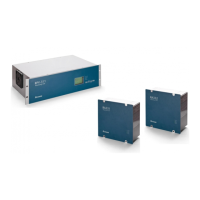Starting a Configuration
To perform a configuration, it is possible to either edit a pre-existing configuration on the equipment, create a
new configuration,or open a file containing a pre-existing configuration.
Receiving an equipment configuration
To receive a configuration file of the RPV, access COMMUNICATION RECEIVE. A window will open and then
the user must enter the RPV IP address and click on the OK button to confirm. This prompts a login
password that can be obtained of the Web Interface of the RPV in the configuration of the access control.
This password can be changed through a new configuration in the Web Interface of the RPV.
When receiving the configuration of RPV, a temp.cfg temp file is saved in the directory config files. It is
recommended that the user save that file with a different name because every time a new file is received, the
previous file will be overwritten.
Creating a new configuration
To create a new configuration access: FILE NEW CONFIGURATION. This will create a template configuration
file, called TEMP.CFG. This file will be saved in the directory CONFIG_FILES, and can be opened and/or
modified.
When saving changes to file TEMP.CFG, it is recommended that the user save it with a different name
because every time a new file is received, the previous file will be overwritten.
Open a configuration
To open a configuration file that has been previously made, access File Open Configuration. Select the
location where the file is stored and click on the file to open it.
Remove links of the configuration file
To remove links of the configuration file, access Tools Remove All Configuration Files. All links will be
removed.
Edit Configuration
o SCL File Input
To select the SCL input file access File Select SCL. A screen will open to perform configuration of the SCL
file, which is shown in Figure 82.
The input files can be SCD or CID and contain the IED GOOSE message configurations, according to
IEC61850.

